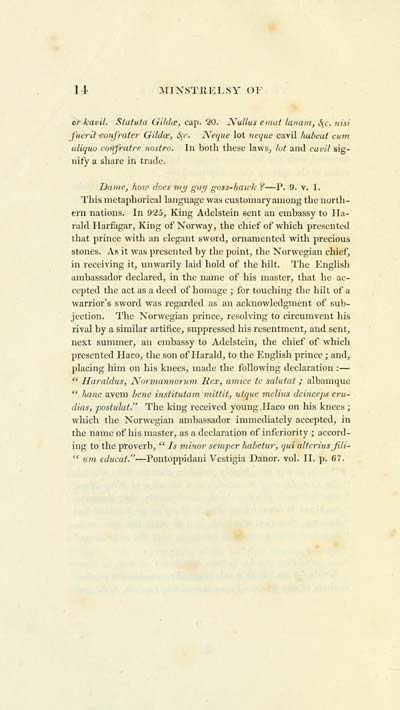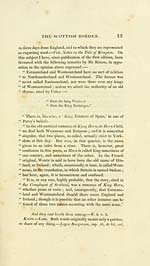Download files
Complete book:
Individual page:
Thumbnail gallery: Grid view | List view

14 :\rixsTUi£LSY or
or kavil. Statuia Gihlce, cap. QO. JS^ullus eiitat laiiaiu, Sjc. nisi
J'uerii ^ouj'raier Gildw, 6^r. Xeifie lot neque cavil habcut cum
uliquo ronfratra nostro. In both these lawS;, lot and canil sig-
nify a sliare in trade.
Dame, how does viij gui/ goss-haivli ? — P. 9. v. 1.
This metaphorical language was customary among the north-
ern nations. In 925, King Adelstein sent an embassy to Ha-
rald Harfagar, King of Norway, the chief of which presented
that prince with an elegant sword, ornamented with precious
stones. As it was presented by the point, the Norwegian chief,
in receiving it, unwarily laid hold of the hilt. The Enghsh
ambassador declared, in the name of his master, that he ac-
cepted the act as a deed of homage ; for touching the hilt of a
warrior's sword was regarded as an acknowledgment of sub-
jection. The Norwegian prince, resolving to circumvent his
rival by a similar artifice, suppressed his resentment, and sent,
next summer, an embassy to Adelstein, the chief of which
presented Haco, the son of Harald, to the English prince ; and,
placing him on his knees, made the following declaration : —
" Haraldus, Normannorum Hex, amice te sulutat ; albamque
" hanc avem bene institutam mitfit, utque melius deinccps eru-
dias, jjosiulat." The king received young, Haco on his knees ;
which the Norwegian ambassador immediately accepted, in
the name of his muster, as a declaration of inferiority ; accord-
ing to the proverb, " Is viinor semper habetur, qui alterius Jili-
" um educat." — Pontoppidani Vestigia Danor. vol. II. p. 67.
or kavil. Statuia Gihlce, cap. QO. JS^ullus eiitat laiiaiu, Sjc. nisi
J'uerii ^ouj'raier Gildw, 6^r. Xeifie lot neque cavil habcut cum
uliquo ronfratra nostro. In both these lawS;, lot and canil sig-
nify a sliare in trade.
Dame, how does viij gui/ goss-haivli ? — P. 9. v. 1.
This metaphorical language was customary among the north-
ern nations. In 925, King Adelstein sent an embassy to Ha-
rald Harfagar, King of Norway, the chief of which presented
that prince with an elegant sword, ornamented with precious
stones. As it was presented by the point, the Norwegian chief,
in receiving it, unwarily laid hold of the hilt. The Enghsh
ambassador declared, in the name of his master, that he ac-
cepted the act as a deed of homage ; for touching the hilt of a
warrior's sword was regarded as an acknowledgment of sub-
jection. The Norwegian prince, resolving to circumvent his
rival by a similar artifice, suppressed his resentment, and sent,
next summer, an embassy to Adelstein, the chief of which
presented Haco, the son of Harald, to the English prince ; and,
placing him on his knees, made the following declaration : —
" Haraldus, Normannorum Hex, amice te sulutat ; albamque
" hanc avem bene institutam mitfit, utque melius deinccps eru-
dias, jjosiulat." The king received young, Haco on his knees ;
which the Norwegian ambassador immediately accepted, in
the name of his muster, as a declaration of inferiority ; accord-
ing to the proverb, " Is viinor semper habetur, qui alterius Jili-
" um educat." — Pontoppidani Vestigia Danor. vol. II. p. 67.
Set display mode to: Large image | Transcription
Images and transcriptions on this page, including medium image downloads, may be used under the Creative Commons Attribution 4.0 International Licence unless otherwise stated. ![]()
| Early Gaelic Book Collections > J. F. Campbell Collection > Minstrelsy of the Scottish border > Volume 3 > (26) |
|---|
| Permanent URL | https://digital.nls.uk/80620696 |
|---|
| Description | Vol III. |
|---|---|
| Shelfmark | Cam.2.d.19 |
| Attribution and copyright: |
|
| Description | Volumes from a collection of 610 books rich in Highland folklore, Ossianic literature and other Celtic subjects. Many of the books annotated by John Francis Campbell of Islay, who assembled the collection. |
|---|
| Description | Selected items from five 'Special and Named Printed Collections'. Includes books in Gaelic and other Celtic languages, works about the Gaels, their languages, literature, culture and history. |
|---|

